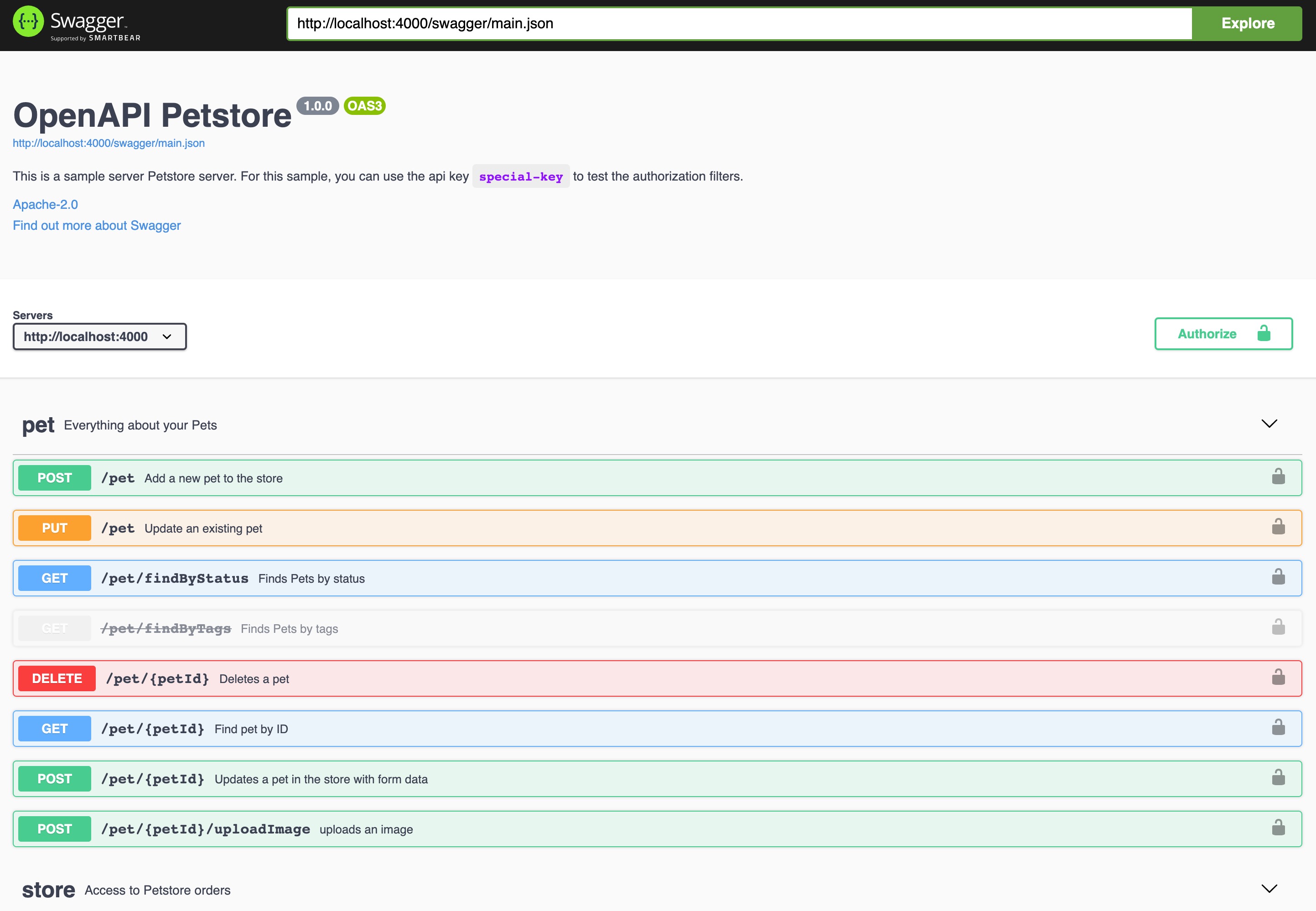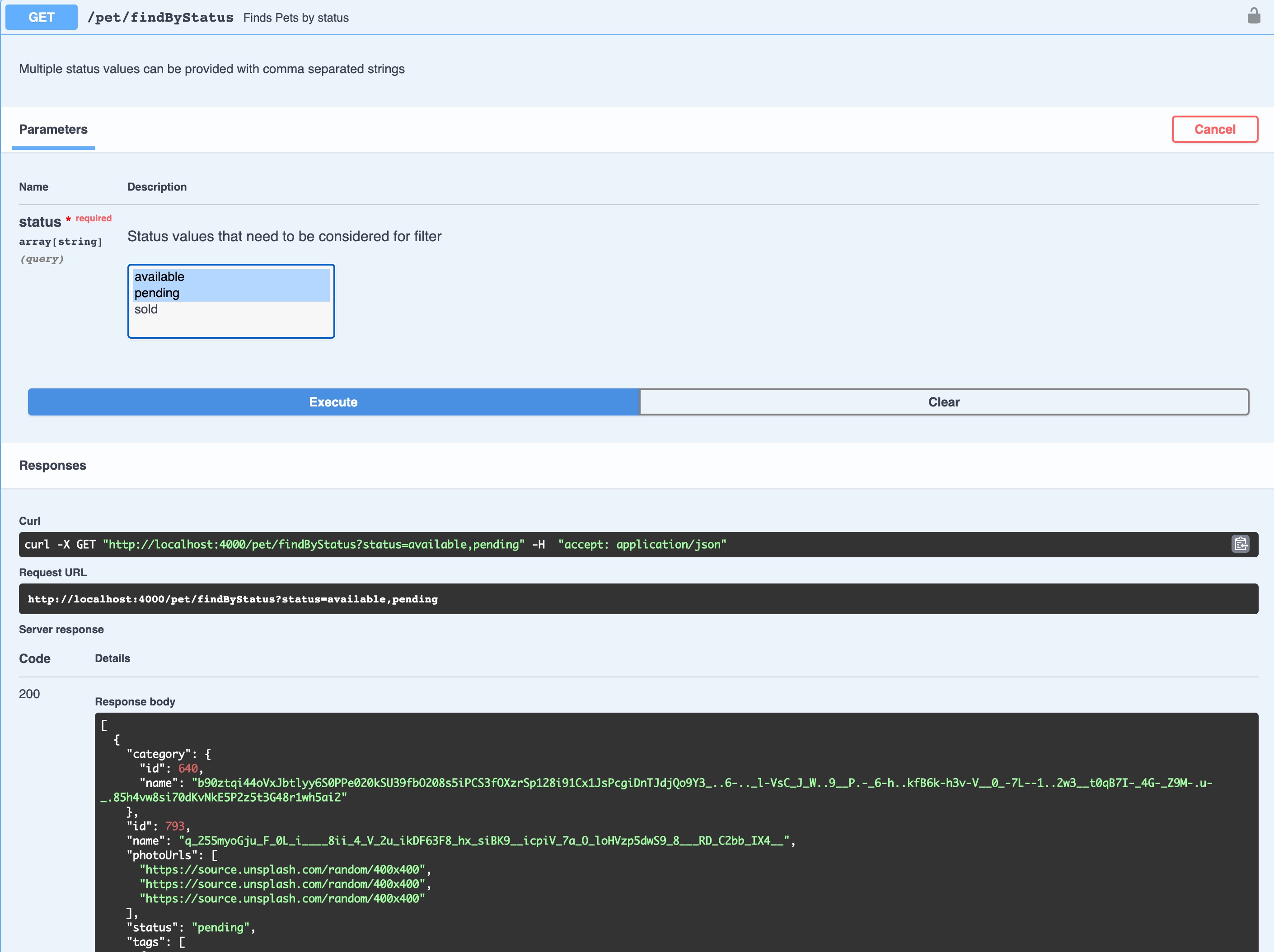tyrchen / Quenya
Programming Languages
Projects that are alternatives of or similar to Quenya
Quenya
Disclaimer: Quenya is under active development and is at its early stage. Please DO NOT use it in prod environment. Use with cautions.
Quenya is a framework to build high-quality REST API applications based on extended OpenAPI spec. For the Quenya extension, see here. With the OAPI spec, Quenya can generate high-quality code for many parts of the API pipeline:
- Preprocessors:
- [x] request validator: validate the request params
- [ ] auth handler: process authentication for the API endpoints
- [ ] access controller: process authorization for the API endpoints
- API handlers:
- [x] fake API handler to generate a fake response for mocking purpose
- [ ] gRPC handler to act as a proxy between your client and your gRPC server (require extended OpenAPI grammar)
- Postprocessors:
- [x] response validator to validate the response body and headers (for dev/testing purpose)
Quenya will also generate property testing, it will use Plug.Test and StreamData to build tests. Requests (url, query, request headers and request body) will be generated and then sent to generated Router, then it will use the response schema to validate the result. Currently the testing only covers happy path.
Quenya will also provide a set of modules, plugs, test helpers to help you build REST APIs easily.
How to use Quenya
Install CLI
First of all, install Quenya CLI:
$ mix archive.install hex quenya_installer
Resolving Hex dependencies...
Dependency resolution completed:
New:
quenya_installer 0.3.0
* Getting quenya_installer (Hex package)
20:22:15.605 [info] erl_tar: removed leading '/' from member names
All dependencies are up to date
Compiling 5 files (.ex)
Generated quenya_installer app
Generated archive "quenya_installer-0.3.0.ez" with MIX_ENV=prod
Are you sure you want to install "quenya_installer-0.3.0.ez"? [Yn]
* creating /Users/tchen/.mix/archives/quenya_installer-0.3.0
Generate APP from an existing OAPI spec
Once you finished installing quenya CLI, you can build a API app with quenya:
$ cd /tmp
$ curl https://raw.githubusercontent.com/tyrchen/quenya/master/parser/test/fixture/petstore.yml > petstore.yml
$ mix quenya.new petstore.yml petstore
* creating petstore/config/config.exs
* creating petstore/config/dev.exs
* creating petstore/config/prod.exs
* creating petstore/config/staging.exs
* creating petstore/config/test.exs
* creating petstore/lib/petstore/application.ex
* creating petstore/lib/petstore.ex
* creating petstore/mix.exs
* creating petstore/README.md
* creating petstore/.formatter.exs
* creating petstore/.gitignore
* creating petstore/test/test_helper.exs
Fetch and install dependencies? [Yn]
* running mix deps.get
* running mix deps.compile
We are almost there! The following steps are missing:
$ cd petstore
You can run your app inside IEx (Interactive Elixir) as:
$ iex -S mix
This will create a new elixir app, copy your spec file (or spec folder) to priv/spec/main.yml, and generate API code based on the spec.
Running the app
Now you can run the app:
$ cd petstore/
$ mix compile.quenya # this command will generate/regenerate code on /gen and /test/gen folders
$ iex -S mix
Erlang/OTP 23 [erts-11.1.3] [source] [64-bit] [smp:16:16] [ds:16:16:10] [async-threads:1] [hipe] [dtrace]
Compiling 44 files (.ex)
Generated petstore app
Interactive Elixir (1.11.2) - press Ctrl+C to exit (type h() ENTER for help)
Just run a few commands without writing even a single line of code, you have an API app ready to use. Try open http://localhost:4000/swagger. You will see an API playground with standard Swagger UI:
It's great but nothing special. Now, try to invoke one of the APIs, say GET /pet/findByStatus:
Amazing! Don't believe what you saw? Try with this command:
curl -X POST "http://localhost:4000/pet" -H "accept: application/json" -H "Content-Type: application/json" -d "{\"name\":\"doggie\",\"photoUrls\":[\"bad url\"]}" -i
HTTP/1.1 400 Bad Request
cache-control: max-age=0, private, must-revalidate
content-length: 33
date: Mon, 30 Nov 2020 04:45:37 GMT
server: Cowboy
Expected to be a valid image_uri.
According to petstore.yml, request body must be a Pet type, and name / photoUrls are required. photoUrls shall be an array of string, with format as image_url (an extended format by quenya). Quenya will validate requests by its schema so here we need a valid url. Let's correct this:
$ curl -X POST "http://localhost:4000/pet" -H "accept: application/json" -H "Content-Type: application/json" -d "{\"name\":\"doggie\",\"photoUrls\":[\"https://source.unsplash.com/random\"]}" -i
HTTP/1.1 200 OK
cache-control: max-age=0, private, must-revalidate
content-length: 376
content-type: application/json; charset=utf-8
date: Mon, 30 Nov 2020 04:51:03 GMT
server: Cowboy
{"category":{"id":683,"name":"Dtlir6vgkz6UeAwK5q4._9--A.--._V_mjp.K--3T.0-e_.7-_qfRmfu"},"id":928,"name":"758Yhl_jx_Rt_fi5fz_JtE_k__JY2J__Tt9Y1","photoUrls":["https://source.unsplash.com/random/400x400","https://source.unsplash.com/random/400x400"],"status":"sold","tags":[{"id":480,"name":"iusto"},{"id":64,"name":"error"},{"id":658,"name":"modi"},{"id":313,"name":"nihil"}]}
Running the tests
Quenya generates property tests for all your API endpoints based on OAPI spec, so before coding your own API handler into the repo, you'd like to be more test-driven, try mix test now:
$ mix test
Compiling 42 files (.ex)
Generated petstore app
....................
Finished in 2.7 seconds
20 properties, 2 failures
Note these tests covers all success cases. In future, we will try to cover all failed cases in Quenya.
How much code Quenya generated for you?
If you have tokei installed, you can have a basic idea on how much code Quenya generated for you:
$ tokei gen test
-------------------------------------------------------------------------------
Language Files Lines Code Comments Blanks
-------------------------------------------------------------------------------
Elixir 83 8152 7060 0 1092
-------------------------------------------------------------------------------
Total 83 8152 7060 0 1092
-------------------------------------------------------------------------------
That's 8k LoC for the petstore spec. The more APIs you defined, the more Quenya will do for you. Once we have most of the parts of Quenya built, this number will be much bigger.
What's under the hood?
Now you have a basic feeling on what's going on. By default, Quenya will generate an API router based on API spec, with a convenient swagger UI. For each route defined in the spec, Quenya will generate a Plug for it. And a Plug is a pipeline which will execute in this order:
- preprocessors: any Plug to be executed before the actual route handler. Here, RequestValidator Plug will help to validate request params against the schema.
- handlers: handlers for the route. This is what you shall put your actual API logic, but for mocking purpose, Quenya generates a fake handler which meets the response schema. In future, Quenya will support gRPC handler which will be very useful if what you need is a grpc proxy (think grpc-gateway).
- postprocessors: any Plug to be executed before sending the response. Quenya can generate a ResponseValidator if you need it. It's good for dev/staging purpose. By default it won't generate it.
Quenya consists of 3 parts:
- quenya_installer: help with Quenya project generation (the CLI you just used).
- quenya_builder: a code generator to generate API implementation based on extended OpenAPI v3 spec. Every time you run
mix compile, Quenya will rebuild the spec to code (need improvement here). - quenya: a library consist of utility functions, tests and a playground to play with API or API stub.
What's the generated code?
If you look at the gen folder in the newly generated app, you'll find all your routes and routers are organized by operationId:
$ tree -L 1
.
├── Petstore.Gen.ApiRouter.ex
├── Petstore.Gen.Router.ex
├── addPet
├── createUser
├── createUsersWithArrayInput
├── createUsersWithListInput
├── deleteOrder
├── deletePet
├── deleteUser
├── findPetsByStatus
├── findPetsByTags
├── getInventory
├── getOrderById
├── getPetById
├── getUserByName
├── loginUser
├── logoutUser
├── placeOrder
├── updatePet
├── updatePetWithForm
├── updateUser
└── uploadFile
20 directories, 2 files
The main router will serve swagger and forward the path (extracted from the spec) to the API router:
defmodule Petstore.Gen.Router do
@moduledoc false
use Plug.Router
use Plug.ErrorHandler
require Logger
alias Quenya.Plug.SwaggerPlug
plug Plug.Logger, log: :info
plug Plug.Static, at: "/public", from: {:quenya, "priv/swagger"}
plug :match
plug Plug.Parsers, parsers: [:json], pass: ["application/json"], json_decoder: Jason
plug :dispatch
def handle_errors(conn, %{kind: _kind, reason: %{message: msg}, stack: _stack}) do
Plug.Conn.send_resp(conn, conn.status, msg)
end
def handle_errors(conn, %{kind: kind, reason: reason, stack: stack}) do
Logger.warn(
"Internal error:\n kind: #{inspect(kind)}\n reason: #{inspect(reason)}\n stack: #{
inspect(stack)
}"
)
Plug.Conn.send_resp(conn, conn.status, "Internal server error")
end
get("/swagger/main.json", to: SwaggerPlug, init_opts: [app: :petstore])
get("/swagger", to: SwaggerPlug, init_opts: [spec: "/swagger/main.json"])
forward "/", to: Petstore.Gen.ApiRouter, init_opts: []
end
The API router contains code for all routes, for example:
put("/user/:username",
to: RoutePlug,
init_opts: [
preprocessors: [Petstore.Gen.UpdateUser.RequestValidator],
postprocessors: [],
handlers: [Petstore.Gen.UpdateUser.FakeHandler]
]
)
When a PUT /user/:username request kicks in, it will be handled by Quenya.Plug.RoutePlug, and it will run preprocessors, handlers and postprocessors in the right order.
Why Quenya?
I've given a topic Building next-gen APIs in 10/2020. The original idea is: why don't I build a code generator to generate API code that we don't need to write repeatedly? I always hold this tenet that everything could be generated should be generated.
Building a high-quality HTTP API app is non-trivial. Good APIs have these traits:
For API users:
- Easy to learn and intuitive to use (the app provides full-fledged and good quality docs / playground)
- Hard to misuse (API is type-safety and provides proper error responses)
- Powerful enough to drive business requirements (flexible, performant)
- Easy to evolve as the products grow
- Opinionated (don't make me think)
For developers:
- Easy to read and maintain existing code
- Easy to write new APIs / extend existing APIs
- Easy to generate code based on API spec (client SDKs, test cases, and even server implementation)
API implementation is just a small part of the API lifecycle, we need API design, mocking, testing, simulating, documentation, deployment, etc.
Quenya tries to help you start with the API spec, iterate it without writing the code, while at the same time various teams can play with the mocking server based on the spec to nail down what is actually needed. We believe this is the best approach to improve productivity.
Why not GraphQL or other solutions?
See the above slides and you'll see why.



